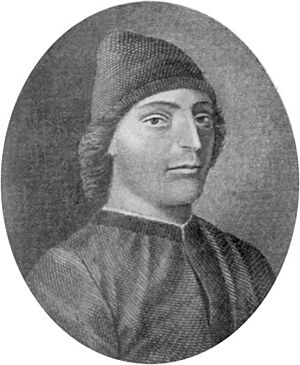Guarino da Verona facts for kids
Quick facts for kids
Guarino
|
|
|---|---|

Guarino da Verona
|
|
| Born | 1374 |
| Died | 14 December 1460 (aged 85–86) |
| Occupation | Interpreter, scholar, translator |
Guarino Veronese, also known as Guarino da Verona (born 1374 – died 1460), was an important Italian scholar during the time of the Renaissance. He was a humanist, which means he loved studying ancient Greek and Roman writings. Guarino was also a skilled translator of old Greek texts.
He learned a lot from Manuel Chrysoloras, a famous Greek professor. Chrysoloras was the first person to teach Greek in medieval Italy. Guarino studied with him in cities like Florence and Venice.
Guarino's Life and Studies
Guarino was born in Verona, a city in medieval Italy. He traveled far to study the Greek language and its literature. For five years, he lived in Constantinople, which was the capital of the Byzantine Empire. There, he was a student of the famous scholar Manuel Chrysoloras.
When Guarino decided to return home, he had collected many valuable old Greek writings. These were called manuscripts. It is said that he lost one of these cases of books in a shipwreck. This made him so sad that his hair supposedly turned gray overnight!
After returning to Italy, Guarino started teaching Greek. He taught in Verona, then in Venice, and later in Florence.
Teaching and Influence
In 1436, Guarino became a Greek professor in Ferrara. A powerful leader named Leonello, Marquis of Este, supported his work. Guarino's way of teaching was very well-known. Students came from all over Italy and even from places as far as Kingdom of England.
Many of his students became famous scholars themselves. One of them was Vittorino da Feltre, another important humanist and teacher. Like Vittorino, Guarino would sometimes use his own money to help students who were poor.
From 1438, Guarino also worked as an interpreter. He helped the Greek speakers at important church meetings in Ferrara and Florence. These meetings were called ecumenical councils. He was greatly influenced by another Greek scholar and thinker named Gemistus Pletho. Guarino passed away in Ferrara in 1460.
Guarino's Important Works
Guarino translated many important texts from Greek into Latin. His main translations include works by Strabo and some of the Lives written by Plutarch. He also created a summary of Greek grammar based on what he learned from Chrysoloras.
Besides translations, Guarino wrote comments on the works of other famous writers. These included Persius, Martial, and Juvenal. He also wrote about some writings by Aristotle and Cicero. It is believed that he helped design the famous Studiolo of the Palazzo Belfiore, a special study room. He also exchanged letters with the writer Isotta Nogarola.


